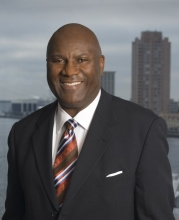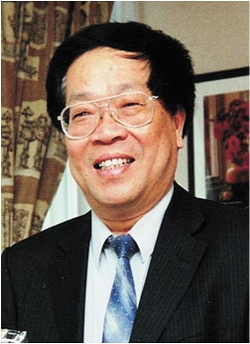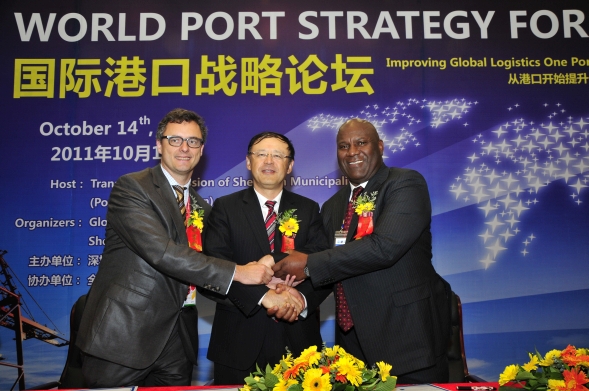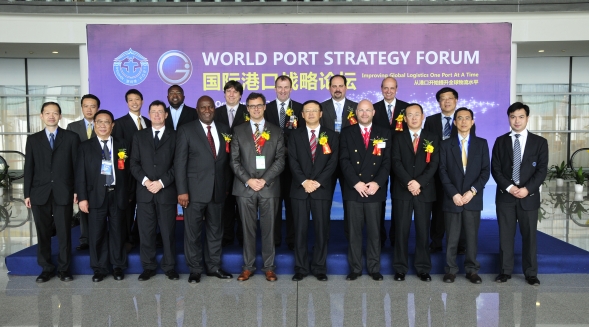[dopts id=”81″]
THE ROLE OF PORT AUTHORITY’S IN GLOBAL LOGISTICS
The first edition of the World Port Strategy Forum brings together the world’s leading Port Authority CEO’s to discuss and debate their changing role in the global supply chain. Port authorities are no longer content to sit back and play the role of the landlord. Competition between ports is fierce, and in some cases the age old reliance on physical location as a Unique Selling Point (USP) is being diminished by greater levels of intermodality in the hinterland.

Kieran Ring
CEO
Global Institute
of Logistics __________________
FORUM MODERATOR
Port authority “Thought Leaders” now see their role in a much broader way and in particular are focussed on the quality of service the shipping lines customer, the beneficial cargo owners and non vessel operating companies receive from the port and its stakeholders as a whole.
Historically ports were measured on their ability to accommodate ships and other modes of transport effectively and efficiently. Contemporary developments in transportation, however, dictate that emphasis has shifted to the ability of ports to fulfil new roles in the logistics era within the context of operating as part of an integrated global supply chain system.
The port is part of a cluster of organizations in which different logistics and transport operators are involved in bringing value to the ports end user, whether it be the shipping line or the beneficial cargo owner.
The role of modern seaports involves integration into the supply chain, and fulfilling this role means greater ability of the port to satisfy customers and achieve its objectives. In this role, the port is considered as part of a cluster of organizations in which different logistics and transport operators are involved in bringing value to the final consumers. In order to be successful, such channels need to achieve a higher degree of coordination and cooperation. The determination of the parameters that encompass the extent of integration of ports/terminals in global supply chains has, therefore, become of great importance for ports. This demand has led to what is termed “Port Centric Logistics”
The Institute traces the origin of Port Centric Logistics back here to South China and the Port of Shenzhen and pinpoints the local port community as the Pioneers in shaping both the business model and best practices that have come to shape port centric logistics globally.
Shenzhen is now embracing a new vision which it is driving through a sister port program which has seen it create formal relationships with 15 of the worlds leading port communities through their respective authorities. Assisted by the Institute, the intention is over time to strengthen these alliances, firstly bilaterally and in the future multilaterally.
The World Port Strategy Forum has been established as a result of these efforts and will provide the platform through which like minded ports from across the world can “Share With, Learn From & Benchmark With Each Other” in pursuit of greater innovation in and better delivery of port related services to the container supply chain.
The format for the meeting is designed to create a flow of conversation around the central theme of THE ROLE OF PORT AUTHORITY’S IN GLOBAL LOGISTICS. Unlike the traditional conference format, the meeting will be held in forum style, where all 25 guest experts will engage with the subject throughout the entire day. The narrative is informed by a keynote address followed by a series of short presentations at strategic intervals throughout the forum.
The presentations given by recognized industry experts act as segues to the next area to be debated. On completion, the subject is discussed and debated in the forum, before delegates are invited to engage. Each subject is supported by a series of talking points which are agreed in advance through local and global research and in particular in coordination with delegates and experts. The talking points provide a roadmap, at end of which we hope to have exhausted the subject from all angles and points of view
SHENZHEN PORT AUTHORITY HOST OF WPSF 2011
Shenzhen, as Special Economics Zone, has got significant achievement in the past 30 years after the economics reform. As one of important parts, Shenzhen port logistics have also got a great development. Shenzhen not only becomes one of the container hub of China, but also becomes one of the biggest ports in the world. Though the global economics is getting complicated, port and shipping market is facing huge challenge, we are still confident in the future of Shenzhen port logistics.

HUANG MIN
Chairman
Shenzhen Transport
Commission
____________
CONFERENCE CHAIRMAN
Shenzhen has been the 4th busiest port in the world for 8 years. It has been China Transportation Hub and Container Hub in South China. HPH Group, China Merchant, Wharf, Maersk and other shipping world famous brands have already invested in Shenzhen.
From the first berth set up in 1980, there are ten port area have been formed, including Shenkou, Chiwan, Mawan, Yantian, DaChanWan, ShaYuCong, XiaDong, DongJiaoTou, FuYong and NeiHe. Total investment is around 60 Billion RMB.
Up to end of 2010, there are 176 berths, within which there are 69 berths with 10,000 tons capacity and 44 container berths. The yearly handling capacity is around 194.9 Million tons and 18.91 million TEU.The throughput of 2010 is 220 million tons, which is 15.59% increase of last year.
Container throughput is 22.5 million TEU, which is 23.1% increase.
The Scale of Shenzhen Port Logistics Industry
Port Logistics Industry includes main port business, supporting services, connected manufacture, financial and information service.
There are 7 port investment companies, including Yantian Port Group, China Merchant, Nanshan Development. And there are 35 port operators. There are 40 international shipping lines calling Shenzhen, 32 ship agencies, 1500 international forwarders. And there are around 50 registered water transportation companies, owning container ships, bulk vessel, gas and passenger transportation.
There are over 100 warehouse operators, 80 companies providing related vessel service, and more than 2000 trucking companies. Up to end of 2010, there are 230 line haul services in Shenzhen, which brings 24353 callings. At the same time, 8 domestic services has been started. From Shenzhen, we connect with more than 300 ports in over 100 countries.
In the past 30 years, Shenzhen Port Logistics have taken great impact on transportation facilities, attracting foreign investment and strenghtened international trade. The modern logistics industry has been developed rapidly, which has created more opportunity for Port Logistics. The modern logistics industry has been formed. Supported by system management of transportation, sea port and air port business, logistics parks and the whole industry development, we could keep a steady and rapid development.
The logistics service has been improved. Up to end of the 11th 5-years plan, there are 14,800 logistics companies, within which there are more than 300 supply chain companies. The supply chain service system has been formed, which is plan-purchase-manufature-delilver-return. The traditional logistics service has been changing to 3 party logistics and supply chain services. Sea, road and air transportation network, logistics park and data management system have been upgraded. Shenzhen will work more closely with HK in Shipping area.
The strategic of logistics adaptation is to develop port supply chain
The competition among ports has been changed to supply chain competition. The supply chain is based on port and shipping industry, including all related service providers. The port should connect with other service providers to extend logistics function and provide There are more and more manufacturers and trading company out-sourcing their logistics service. So There are more and more supply chain companies starting extended services.
The current 7 key logistics parks have been connected with high way and direct/indirect businss relationship with ports. Walmart, Carrerfour, IKEA have set up Distribution Center. DHL, UPS, Maersk Logistics, APL Logistics, COSCO Logistics and other world famous companies have been working with logistics park and providing global services. The logistics parks has been the key base for port supply chain.
Future Development
According to Shenzhen Government transportation strategic,Shenzhen modern logistics development plan is to build up Shenzhen as the global logistics hub, which only has the function to allocate international resources, but also has the ability to operate international commercial business. Shenzhen would like to be the key port in China coastal transportation and take key part in HK, which is as international shipping center. The container throughput will be 28 million TEU in year 2015.
According to ‘Shenzhen Port Plan’, Shenzhen port includes two sides, six districts and three port areas. The two sides refer to east and west port clusters. Six districts are Yantian, Longang, Nanshan, Dachanwan, Big and Small (two)Islands and Bao’an Ports. Three port areas are Yantian, Nanshan and Dachanwan, which mainly handle container business.
Our mission is to build a world class port, a modern port with competitive, environmental friendly, safe and sustainability
Mr. Huang Min
Director General Transport Commission of Shenzhen Municipality
(Ports Administration)
THE AGENDA FOR THE 2011 WORLD PORT STRATEGY FORUM
Meeting Format: A Forum not a Conference
The format for the meeting is designed to create a flow of conversation around the central theme of THE ROLE OF PORT AUTHORITY’S IN GLOBAL LOGISTICS. Unlike the traditional conference format, the meeting will be held in forum style, where all 25 guest experts will engage with the subject throughout the entire day. The narrative is informed by a keynote address followed by a series of short presentations at strategic intervals throughout the forum. The presentations given by recognized industry experts act as segues to the next area to be debated. On completion, the subject is discussed and debated in the forum, before delegates are invited to engage. Each subject is supported by a series of talking points which are agreed in advance through local and global research and in particular in coordination with delegates and experts. The talking points provide a roadmap, at end of which we hope to have exhausted the subject from all angles and points of view.

YANG LEI
China Director
Global Institute of Logistics
China
_____________________
WORLD PORT STRATEGY FORUM
PRODUCER
______________________
Born and now based in Beijing, Mr. Yang Lei (William) was appointed the Institute’s China Director in September 2010.
[dopts id=”72″]
CLICK IMAGE TO VIEW CONFERENCE AGENDA & PANEL OF EXPERTS
.
.
.
.
.
.
.
.
.
.
.
.
.
.
.
.
.
.
.
.
.
.
.
.
.
.
.
.
GLOBAL INSTITUTE OF LOGISTICS ALL RIGHTS RESERVED
LOGISTICS DEVELOPMENT IN SHENZHEN PORT
MA YONGZHI PORT OF SHENZHEN BIOGRAPHY & SLIDES

MA YONGZHI
Deputy Director General
Shenzhen Port Authority
China
_____________________
GLOBAL INSTITUTE OF LOGISTICS
CHINA CHAPTER
[dopts id=”73″]
CLICK IMAGE TO VIEW PRESENTATION
BIOGRAPHY:
INVESTING IN HINTERLAND CONNECTIVITY : PORT OF ZEEBRUGGE CASE STUDY
JOACHIM COENS PORT OF ZEEBRUGGE BIOGRAPHY & SLIDES

JOACHIM COENS
Chairman-Managing Director
Port Authority Bruges-Zeebrugge
Belgium
_____________________
CHAIRMAN
GLOBAL INSTITUTE OF LOGISTICS
EUROPE CHAPTER
[dopts id=”182″]
CLICK IMAGE TO VIEW PRESENTATION
BIOBRAPHY:
BUILDING RAIL COMPETENCE IN THE MODERN PORT : THE CASE FOR VIRGINIA
JERRY A. BRIDGES PORT OF VIRGINIA BIOGRAPHY & SLIDES

JERRY BRIDGES
Executive Director Virginia Port Authority
Virginia
United States of America
_________________
CHAIRMAN
GLOBAL INSTITUTE OF LOGISTICS
NORTH AMERICA CHAPTER
[dopts id=”74″]
CLICK IMAGE TO VIEW PRESENTATION
BIOBRAPHY:
QUALITY SYSTEMS IN PORT COMMUNITY DEVELOPMENT
RAFAEL AZNAR CEO VALENCIA PORT AUTHORITY BIOGRAPHY & SLIDES

RAFAEL AZNAR
P resident
Port Authority Valencia
Spain
_____________________
FOUNDING CHAIRMAN
GLOBAL INSTITUTE OF LOGISTICS
EUROPE CHAPTER
[dopts id=”78″]
CLICK IMAGE TO VIEW PRESENTATION
BIOBRAPHY:
WINNING NEW BUSINESS FOR THE PORT & ITS COMMUNITY
AXEL MATTERN CEO HAMBURG PORT MARKETING BIOGRAPHY & SLIDES

MR. AXEL MATTERN
CEO
Hamburg Port Marketing Germany
Europe
_____________________
ACCREDITED
GLOBAL INSTITUTE OF LOGISTICS
BEST IN CLASS
[dopts id=”77″]
CLICK IMAGE TO VIEW PRESENTATION
BIOBRAPHY:
NAMIBIA THE LOGISTICS CORRIDOR INITIATIVE
ELIAS MWENYO DIRECTOR SALES & SERVICES NAMPORT BIOGRAPHY & SLIDES

ELIAS MWENYO
Director
Port of Walvis Bay Namibia
Africa
_____________________
MEMBER
GLOBAL INSTITUTE OF LOGISTICS
AFRICA CHAPTER
[dopts id=”75″]
CLICK IMAGE TO VIEW PRESENTATION
BIOBRAPHY:
E-TECHNOLOGY TO ENABLE VISIBILITY OF CONTAINERS IN THE PORT COMMUNITY
BAO QIFAN STATE-RANK EXPERT, ENGINEER, ECONOMIST SIPG BIOGRAPHY & SLIDES

Mr. BAO QUIFAN
Engineer & Economist
Shanghai Int. Port Group
China
_____________________
MEMBER
GLOBAL INSTITUTE OF LOGISTICS
CHINA CHAPTER
[dopts id=”80″]
CLICK IMAGE TO VIEW PRESENTATION
BIOBRAPHY:
COMMUNITY OWNED PORTS : PORT OF DOVER CASE STUDY
NEIL WIGGINS CEO INDEPENDENT VESSEL OPERATING PARTNERS BIOGRAPHY & SLIDES

CEO
IVOPS
United Kingdom
_____________________
MEMBER
GLOBAL INSTITUTE OF LOGISTICS
EUROPEAN CHAPTER
[dopts id=”76″]
CLICK IMAGE TO VIEW PRESENTATION
BIOBRAPHY:
RESEARCH THE POTENTIAL FOR A CHAINPORT MODEL BETWEEN SISTER PORTS
The 2011 forum agreed the need for the Institute to research the case for formal cooperation between port authorities and the potential to develop a “Chain Port” model. The ports of Shenzhen, Zeebrugge and Virginia, who are already sister ports agreed to participate formally in the research program.
The 2011 forum established that port authority “Thought Leaders” no longer see their role as been of just that of a landlord, now viewing themselves as “Economic Strategists” on behalf of the port community and the wider economic region. Port Authority CEO’s now focus on the quality of service the shipping line’s customer, the beneficial cargo owners and non vessel operating companies receive from the port and its stakeholders as a whole. They believe that by focussing on overall service level quality by the port community as a whole increase throughput.

THE PORTS OF ZEEBRUGGE, SHENZHEN and VIRGINIA AGREE TERMS OF REFERENCE FOR 2011 -2012 RESEARCH PROGRAM IN TO COLLABORATION BETWEEN MULTIPLE PORTS AND ITS POTENTIAL BENEFITS TO PORTS AND END USERS.
The 2011 forum agreed the need for the Institute to research the case for formal cooperation between port authorities and the potential to develop a “Chain Port” model. The ports of Shenzhen, Zeebrugge and Virginia, who are already sister ports agreed to participate formally in the research program.
The 2012 forum will hear the preliminary outcomes from the research.
CLICK HERE FOR PRESS STATEMENT
.
.
.
.
.
.
.
.
.
.
.
.
.
.
.
.
.
.
.
.
GIL IMPROVING GLOBAL LOGISTICS ONE PORT AT A TIME
THE FOLLOWING VIDEOS COVER THE ENTIRE FORUMS PROCEEDINGS
To comply with length restrictions imposed by YOUTUBE the videos are presented in 16-20 minute sections
Part 1

